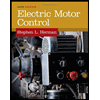
Concept explainers
Explain the typical uses of flow switches.
Explanation of Solution
A flow switch is a device that can be placed into a pipe so that when an air or liquid flows against a device called paddle, a switch is activated. This switch either closes or opens an electrical contact. The electrical contacts may be wired to energize the motor starter coils, indicating lights or relays. The flow switch is also used to protect the damage of the device and also for protection of cooling circuits. Refer to Figure 12-2 in the textbook where the flow switch consists of both normally open and closed contacts. Flow switches are typically used in petroleum and chemical industries to sound alarm or light when signal flows and to sound warning light when flow stops.
Conclusion:
Thus, the typical uses of flow switches have been explained.
Want to see more full solutions like this?
Chapter 12 Solutions
EBK ELECTRIC MOTOR CONTROL
- Don't use ai to answer I will report you answerarrow_forwardanA fluid level control system includes a tank, a level sensor , a fluid source and an actuator to control fluid inflow. Show how the fluid level could be digitally controlled using a block diagramarrow_forwardsee the following imagearrow_forward
- Calculate A, B, C, and D constants, sending end voltage and sending end current of a 3-phase, 50-Hz overhead transmission line 100 km long has the following constants Resistance/km/phase = 0.1, Inductive reactance/km/phase 0.20, Capacitive susceptance/km/phase = 0.04 x 10 siemen. when supplying a balanced load of 10,000 kW at 66 kV, p.f. 0-8 lagging. Use nominal T method. andarrow_forwardDon't use ai to answer I will report you answerarrow_forwardNO AI PLEASE WILL REJECTarrow_forward
- NO AI PLEASE WILL REJECTarrow_forwardDon't use ai to answer I will report you answer. Please give explanation for both correct options and incorrectarrow_forward14:00 APP Voi) 5G 鼷浴醵郯興47% atheva.cc/index/index/index.html The Most Trusted, Secure, Fast, Reliable Cryptocurrency Exchange Get started with the easiest and most secure platform to buy, sell, trade, and earn Cryptocurrency Balance:1000.00 Recharge Withdraw Message About us BTC/USDT ETH/USDT EOS/USDT 83259.00 1841.46 83259.00 +1.02% +0.08% +1.02% Operating norms Symbol B BTC/USDT Latest price 24hFluctuation 83259.00 +1.02% ETH/USDT 1841.46 +0.08% B BTC/USD illı 83259.00 +1.02% Home Markets Trade Record Mine О <arrow_forward

 Electricity for Refrigeration, Heating, and Air C...Mechanical EngineeringISBN:9781337399128Author:Russell E. SmithPublisher:Cengage Learning
Electricity for Refrigeration, Heating, and Air C...Mechanical EngineeringISBN:9781337399128Author:Russell E. SmithPublisher:Cengage Learning

